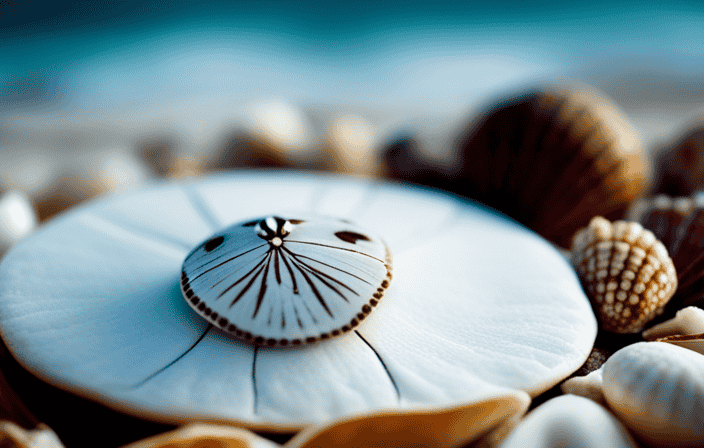Symbolism serves as a connection between cultures, allowing us to access deeper meanings. The sand dollar is a perfect illustration of this concept. Despite its simplicity, this creature from the sea holds a wealth of spiritual and cultural importance across the globe.
From Native American beliefs in hope and transformation to Christian associations with birth and resurrection, the sand dollar’s significance is vast.
Join me as we explore the intricate symbolism of the sand dollar and its ability to bring us closer to the complexities and beauty of the universe.
Key Takeaways
- The sand dollar is considered as a sacred object in Native American culture and holds significance in various cultural and spiritual traditions.
- It symbolizes hope, resilience, wealth, abundance, and transformation, representing strength, unity, and perseverance.
- The five-pointed star on a sand dollar represents earth, air, water, fire, and spirit, reflecting the interconnectedness of life and the universe.
- The spiritual meaning of the sand dollar can vary across cultures, representing earth’s cycles, the moon and tides, or being seen as a beautiful and mysterious creature of the sea.
The Symbolic Significance
The symbolic significance of the sand dollar is fascinating, as it holds various spiritual meanings and cultural connections.
In Native American culture, the sand dollar is seen as a sacred object, symbolizing hope and resilience in difficult times. It also represents wealth, abundance, and transformation.
The five-pointed star on the sand dollar is believed to symbolize earth, air, water, fire, and spirit, reflecting the interconnectedness within the universe.
In Christian belief, the sand dollar represents birth, death, and resurrection, while in Chinese symbolism, it represents wealth and prosperity.
The sand dollar’s five-fold symmetry represents the cycle of life. It is used in spiritual practices to promote inner peace and harmony.
The spiritual meaning of the sand dollar can vary across cultures, symbolizing the earth’s cycles, the moon and tides, or simply the beauty of the sea.
Connecting with the spiritual meaning of the sand dollar involves meditation, placing it on an altar, or wearing sand dollar jewelry. It allows us to appreciate the interconnectedness of life and gain spiritual insight.
Importance in Native American Culture
Growing up in a Native American community, I have witnessed the deep reverence and importance placed on the sand dollar as a sacred object. In our culture, the sand dollar holds significant spiritual meaning. It represents not only the cycles of the earth but also our connection to the elements and the universe.
The five-pointed star found on the sand dollar symbolizes the balance of earth, air, water, fire, and spirit. It reminds us of our unity with all living beings and the interconnectedness of life. The sand dollar also represents strength, resilience, and perseverance in the face of challenges. It serves as a reminder to have hope and to trust in divine intervention.
The sand dollar is truly a powerful symbol that promotes inner peace and harmony within oneself and the world around us.
Christian Beliefs and Symbolism
In my experience as a member of a Native American community, the sand dollar holds a special place in Christian beliefs and symbolism. It is much like a guiding star leading us towards spiritual understanding.
In Christian belief, the sand dollar is associated with the birth, crucifixion, and resurrection of Jesus Christ. The five-pointed star found on the sand dollar represents the Star of Bethlehem, guiding the wise men to the birthplace of Jesus. It is a symbol of hope and divine intervention.
The sand dollar’s five-fold symmetry represents the five wounds of Christ, and its circular shape symbolizes eternity. Christians see the sand dollar as a reminder of the cycle of life, death, and resurrection. It is a powerful symbol of faith, reminding us of the transformative power of belief and the promise of eternal life.
Chinese Symbolism of Wealth
When I think about the sand dollar’s importance in Chinese culture, it reminds me of the symbolism of wealth and prosperity. In Chinese symbolism, the sand dollar is believed to represent financial abundance and good fortune. It is considered a powerful talisman for attracting wealth and prosperity into one’s life.
This belief is rooted in the round shape of the sand dollar, which resembles a coin, and the intricate patterns on its surface, which are reminiscent of Chinese currency. The sand dollar is often displayed in homes and businesses as a symbol of prosperity and to invite financial success.
It is also used in traditional Chinese ceremonies and rituals to bless individuals with wealth and good luck.
Five-Pointed Star Meaning
As I gaze at the sand dollar, the five-pointed star captivates my attention, its radiant rays reaching out like a celestial embrace. The spiritual meaning behind this symbol holds great significance across various cultures and traditions.
In Christian belief, the star represents the Star of Bethlehem, symbolizing the birth, crucifixion, and resurrection of Jesus Christ.
In Pagan and Wiccan traditions, it is seen as an earth element and a representation of the Great Spirit and balance in Native American mythology.
The five-pointed star also reflects the interconnectedness of life and the universe, reminding us of our place within the cosmic order. It serves as a reminder of the cyclical nature of existence and the harmony that can be found within it.
By contemplating the five-pointed star on the sand dollar, we can gain a deeper understanding of the spiritual and universal truths that it represents.
Connecting with Spiritual Meaning
To connect with the spiritual meaning of the sand dollar, I find it helpful to meditate while holding this sacred object. This allows me to fully immerse myself in its energy and symbolism. During meditation, I focus on the intricate design of the sand dollar, contemplating its representation of unity, balance, and interconnectedness within the universe.
Here are four ways I connect with the spiritual meaning of the sand dollar:
- Placing a sand dollar on my altar as a visual reminder of its significance.
- Wearing sand dollar jewelry to carry its energy with me throughout the day.
- Channeling the inner strength and resilience symbolized by the sand dollar during challenging times.
- Gaining spiritual insight and clarity by appreciating the cycles of life and the beauty of the interconnected world.
By engaging in these practices, I deepen my connection with the spiritual meaning of the sand dollar and incorporate its symbolism into my daily life.
Variations Across Cultures
I appreciate the diverse interpretations and understandings of the sand dollar’s symbolism found in different cultures. It is fascinating to see how this small marine creature holds such significance and meaning across various cultural beliefs and traditions.
In Native American cultures, the sand dollar represents the earth’s cycles and the interconnectedness of life. In some cultures, it symbolizes the moon and tides, highlighting its connection to the natural world. Other cultures view the sand dollar as a beautiful and mysterious creature of the sea.
These variations in spiritual meaning reflect the complexity and beauty of the universe and provide individuals with different perspectives to connect with.
It is through exploring these cultural connections that we can gain a deeper understanding of the symbolic significance of the sand dollar and its spiritual meaning.
Moving on from the variations in the spiritual meaning of the sand dollar across different cultures, let’s now delve into the significance of sand dollars as a beautiful and mysterious creature of the sea in some cultural beliefs. In these cultures, the sand dollar is perceived as more than just a symbol; it is revered as a living entity that holds deep spiritual significance. Its intricate design and delicate features are seen as a testament to the complexity and beauty of the universe. The sand dollar’s presence in the ocean, its natural habitat, is believed to be a reminder of the ever-changing cycles of life. To capture the essence of this belief, let’s take a closer look at the contrasting aspects of the sand dollar in the following table:
| Symbolism | Interpretation |
|---|---|
| Beauty | Represents the awe-inspiring wonders of the universe |
| Mystery | Reflects the enigmatic nature of life and existence |
| Fragility | Symbolizes the delicate balance within the natural world |
| Resilience | Signifies the ability to adapt and survive in challenging environments |
| Transience | Reminds us of the impermanence and fleeting nature of life |
Through the lens of these cultural beliefs, the sand dollar becomes a profound symbol that invites contemplation on the mysteries of existence and our place within the interconnected web of life.
Frequently Asked Questions
Are sand dollars considered lucky charms in any culture?
Yes, sand dollars are considered lucky charms in various cultures. They are believed to bring good luck, fortune, and prosperity. In Native American and Chinese traditions, they symbolize wealth and abundance.
How are sand dollars used in spiritual practices to promote inner peace and harmony?
In spiritual practices, sand dollars are used to promote inner peace and harmony. By meditating with a sand dollar, wearing sand dollar jewelry, or placing one on an altar, individuals can channel their inner strength and gain spiritual insight.
What is the significance of the five-fold symmetry in the sand dollar’s cycle of life symbolism?
The five-fold symmetry in the sand dollar’s cycle of life symbolism signifies the interconnectedness of various elements. It represents the balance between birth, growth, death, transformation, and rebirth. This symmetry reflects the complex and beautiful nature of life’s continuous cycles.
Are there any rituals or ceremonies associated with sand dollars in Native American culture?
There are no specific rituals or ceremonies associated with sand dollars in Native American culture. However, sand dollars are considered sacred objects and hold symbolic meaning of hope, resilience, and interconnectedness within the universe.
Can wearing sand dollar jewelry bring any specific spiritual benefits or energies?
Wearing sand dollar jewelry can bring spiritual benefits and energies. It symbolizes hope, abundance, and unity. It connects us to the interconnectedness of life and reminds us of our inner strength and resilience.
Conclusion
In conclusion, the sand dollar holds immense symbolic significance across various cultures and spiritual traditions. From representing hope and resilience in Native American culture to symbolizing birth, death, and resurrection in Christian belief, this small sea creature carries profound meaning.
Its five-fold symmetry and the five-pointed star on its surface reflect the interconnectedness of life and the elements within the universe. By connecting with the spiritual meaning of the sand dollar through meditation or wearing sand dollar jewelry, one can cultivate inner peace and appreciation for the complexity and beauty of existence.
As the adage goes, ‘Like the sand dollar, life’s interconnectedness reveals itself in the smallest of details.’









